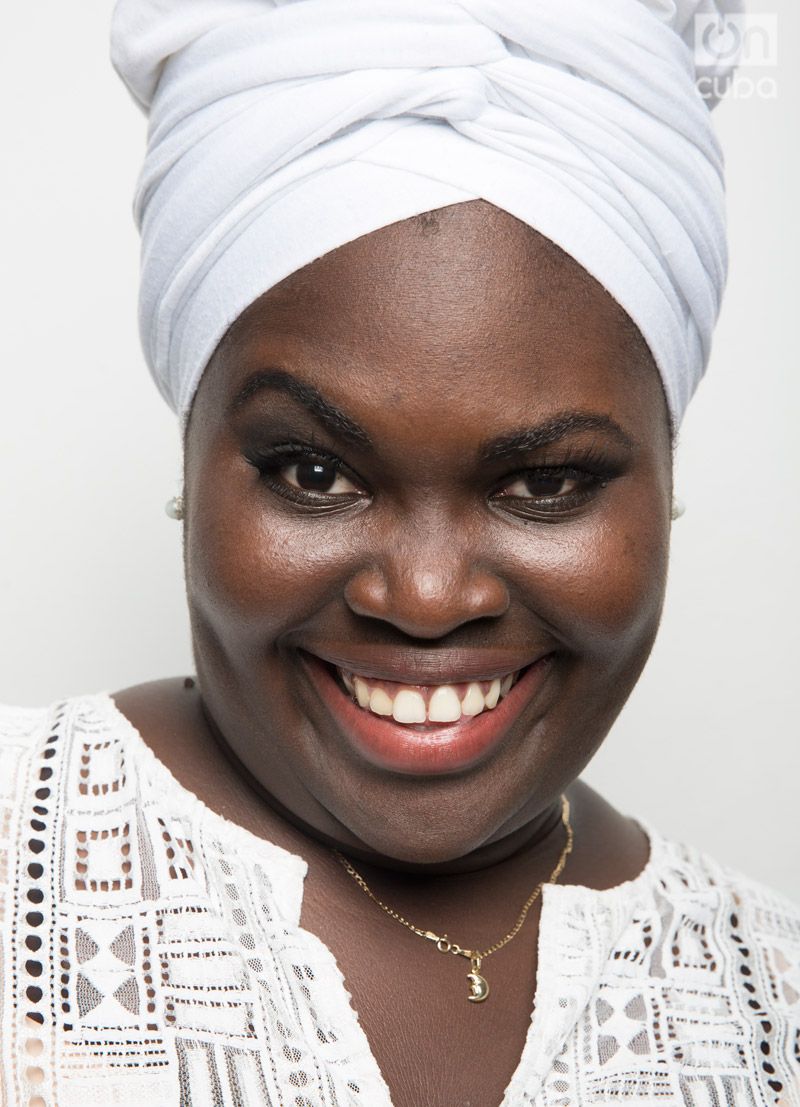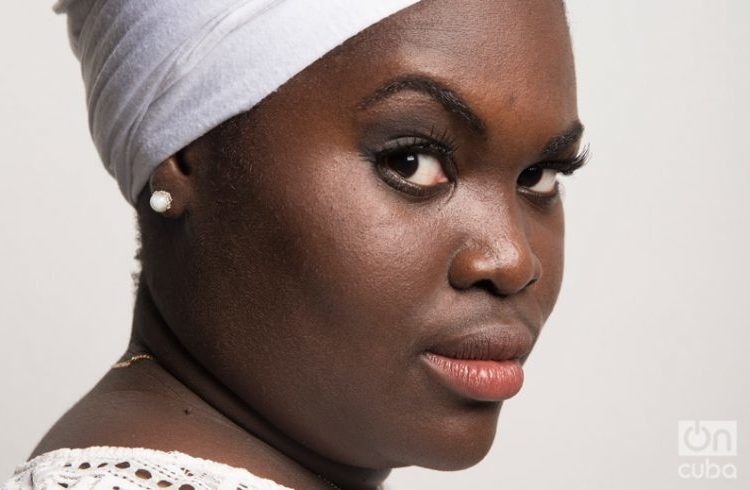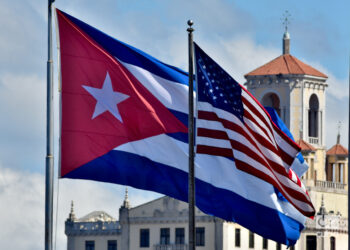The day of her second Santeria birthday – April 24 – , Daymé Arocena was not in Cuba, but rather in London. The capital of the United Kingdom, with its aura of rainy and refined city, did not seem like a proper scenario for an Afro-Cuban celebration. However, Daymé was there: taking out her shells – each in its bag -, putting up an altar with old abandoned record boxes, in a sort of “home” that previously was the venue of Brownswood Recordings, the record company that represents her today.
The rest seemed simple: going out to buy flowers, sweets, fried rice, rum, honey and cigars; inviting friends, among them Gilles Peterson, the owner of Brownswood and Daymé’s adoptive father in the British city. Everything was ready by 10 in the morning.
Later Daymé would fall asleep and would dream a song: “It’s Not Gonna be Forever,” the tenth theme of her new album Cubafonía.
And it appeared to her exactly the same as it appears today on the record; the lyrics and music, everything in one same combo. Because Daymé Arocena composes in dreams. She has that ashé (luck): “The song was a birthday present. It’s catchy, people listen to the entire record and it’s the one that stays with them. It was that, a present for the effort I made to celebrate the birthday in London, for not having let it go by.”

The oneiric and the religious are in Daymé. They emerge without pressures. They simply flow. Other themes that share these same foundations are present in Cubafonía – a record production released last March 10 in all the digital platforms, and which brings together young Cuban musicians: Gastón Joya and Emir Santa Cruz, in the arrangements; and Ruly Herrera, Jorge Luis Lagarza, Yaroldy Abreu, Bárbara Llanes, among others.
There was one time in which La Lupe appeared to her in dreams. That day Daymé had “listened to her a lot” and she fell asleep with that peculiar sound in her head. The Queen of Latin Soul came in the form of music and turned Daymé into the emissary of “a song that never was, but that has to be now.” That’s how “Negra Caridad” was born, the fifth track of the album, a bombshell in all senses, with parallelisms and plays on words, allegories to Oshún – or, what is the same: to Caridad -, and bearing the inheritance left to her by La Lupe and Nina Simone, both the non plus ultra for that singer who, after being signed up by the Brownswood Recordings label – and after the very well-known boom -, would be classified as Cuban music’s new hope.
“With ‘Negra Caridad’ I have a crossing, a strange spiritual incarnation. If I had not paid full attention, I wouldn’t have composed a song like that. I feel I got it from the hereafter. It’s a song that remains in someone’s inspiration and was never finished. It’s not from our time and it’s not completely mine.”
Daymé Arocena can compose two songs in one day or two songs in a month. The rhythm of creation doesn’t depend on her. There are songs that come to her complete, in one round; others appear in harmonic sequences. In this process, the lyrics are her nemesis. There’s where she suffers. She doesn’t feel she’s a poet. She questions herself and she suffers.

“That’s why there are songs, like ‘Ángel’ – also from Cubafonía – in which I never found the way of saying what I wanted, however I feel it is complete. It’s a song about resignation. When something can’t be…when something was not.”
And in that inexplicable moment her songs close cycles, especially love cycles: “I’m life’s lover; I fall in love as easily as I fall out of love. After the catharsis, the bomb explodes and the ashes fall, that’s when the music starts ringing in my ears. And when I finish the song, the cycle is closed, that’s the end of love.”
The day Daymé dreamed her Itá – a reading the Santeria priest does for a person on the fourth day after receiving the saint, their fate – she woke up and recorded it on her cell phone. On the following morning everything was there: a new theme, transparent from the first to the last word. In “La rumba me llamo yo,” Daymé Arocena sings things like these: “My mother says that blacks are everywhere,/ that they approach to cast a shadow over me/ and that she doesn’t want them near me./ I am the daughter of luck,/ that what I have is natural,/ that I not share my glory so no one wishes me evil.”
She sings things like these and thinks about the people, in what they will say about her after listening to those lyrics. “Because no one is as happy as I am about my negritude, about my ethnics and everything that I bear. But in love the saint says no matter how much I like the dark man, he pushes him away. The clash is very strong. Which is why the song is personal and completely alien to racist questions.”
But “La rumba me llamo yo” is also a song to chance, to good fortune. From her religion Daymé knows that her sign means “Daughter of luck.” She knows that her name is “Corona” (Crown). She also knows that she pulls the strings: “My head destroys me and saves me.” And with that wisdom she embarks on a trip. A trip to the interior of Cubafonía where “La rumba…” supports and gives continuity to the record, because it is the song that is most directly connected to folkloric music.
It is joined by others: “Lo que fue,” “Maybe Tomorrow,” “Cómo,” “Todo por amor,” “Valentine” and “Mambo Na’má,” a practically onomatopoeic theme that is located precisely at the center of the record production’s dramatic writing. A theme that emerged in New Orleans, in the midst of the traditional festivities of Louis Armstrong’s city, where a funeral cortege accompanies its dead based on religious hymns, rhythm and blues and jazz. Daymé once got into that second line – as the ritual is known -, running after the live music. She, who is 1.60 m tall, tormented, in the middle of a sea of people, could only see the feet of those who were beside her. There she felt a strange connection between those feet and the mambo. “That melody that begins the theme, ‘uhuh, uh, uh, uhuh,’ came to me there. I made the link with the mambo’s rhythm and that New Orleans rhythm I felt was so Cuban.

“Because what happens between the United States and Cuba is that the genetic formation is very similar. It’s the same slave suffering, the same mixed-race foundations and, therefore, the rhythms are very alike. Some time ago I was listening to Bobby Carcaccés and he said: When Chano Pozo and Dizzy Gillespie met…it was love, that’s why they created Latin jazz. Perhaps ‘Mambo Na’ma’ is like Chano and Dizzy.”
But in Cubafonía there is a spontaneous parallelism with Nueva Era, the album debut that in late 2015 was nominated as one of the best records of the year, according to the U.S. National Public Radio. The records start with a song to the deities of the Yoruba religion. While Nueva Era was an atypical record, not too premeditated, and its first single – “Madres” – is totally improvised, the truth is that the folklore, like now in “Eleggua,” emerges from the first beat. One sings to Oshún, the goddess of the sea, and to Yemayá, the goddess of fertility, protector of children and mothers; the other pays tribute to the gatekeeper of the roads, the god that opens or closes everything.
“That’s why the theme that would open Cubafonía has to be ‘Eleggua.’ The analogy is merely fortuitous. Everything in Cuban music begins based on folklore, on Afro-Cuban religious music. That is the first vision an artist has if he/she wants to be autochthonous. I think, and I say it based on respect, that Santeria is the Cuban national religion, because it is the only one that was born in Cuba.
“The Santeria that is practiced in Cuba is not the Yoruba from Nigeria; it’s not the Catholicism from Spain. It is the origin that came later. For example, the batá drum beats are the rhythmic foundations of all Cuban music, from the son to the reguetón. It’s incredible, but there’s no way to separate one thing from the other, that’s why Cuban music sounds different. That’s why we are different.”










